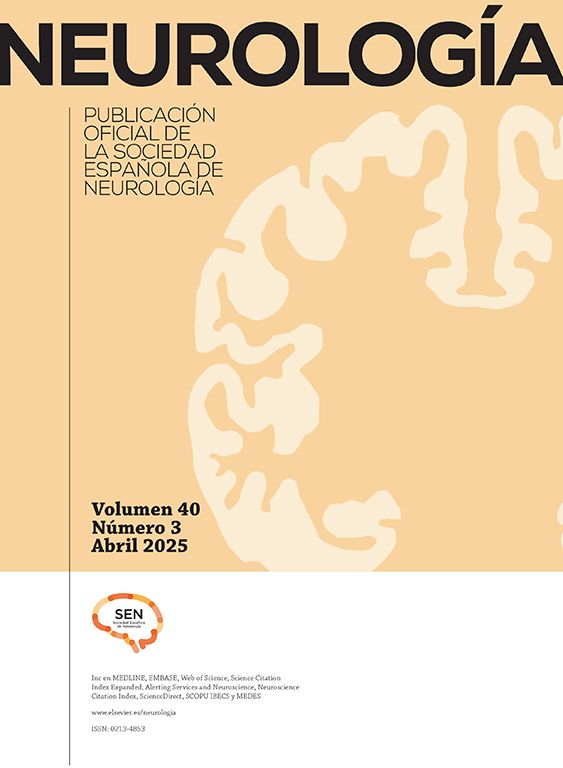We present a 73-year-old female, with a recent diagnosis of idiopathic sicca syndrome, with progressive xerostomia and xerophthalmia, but with negative anti-Ro and anti-La antibodies, and a negative result after a biopsy of salivary glands was performed. She developed involuntary movements affecting the perioral and ocular muscles, with a rapidly progressive course, until vision, speech and swallowing were severe limited.
Examination revealed marked hypertrophy of bilateral plastysma muscles, and a hyperkinetic, repetitive, arrhythmic movement disorder in the form of segmental dystonia involving periocular, mandibular, and cervical muscles, producing ocular occlusion and mouth opening (a combination known as Brueghel syndrome) (Video-A). The dystonia worsened with motor activation maneuvers, the patient had no voluntary control over it, and it was not present during sleep.
With the recognition of this segmental, progressive, late-adulthood onset isolated dystonia, an extensive etiological study is performed, with blood analysis (including autoimmunity, thyroid, copper, etc.), CSF study and MRI, showing no alterations. Brain perfusion SPECT with Technetium-99m HexaMethylPropyleneAmine Oxime showed marked bilateral frontal hypoperfusion (Left>Right), with increased basal ganglia perfusion (Fig. 1).
(A) SPECT sagittal slide: hypoperfusion in anterior part of the brain involving frontal, temporal, and parietal lobes. (C) SPECT coronal slide: hypoperfusion in both cerebral hemispheres, predominantly in the left hemisphere and bilateral and symmetric hyperperfusion in the basal ganglia. (B) Brain MRI axial slide showing brain atrophy in the frontotemporal regions predominantly in the left hemisphere.
Various symptomatic treatments are tried, including biperiden, trihexyphenidyl and baclofen, with partial response. Finally, botulinum toxin (Onabotulinumtoxin type A) infiltrations were started, and after adjustment of dosage, optimal control was achieved (Video-A) with infiltration of orbicularis oculi, procerus, frontalis, risorius, and platysma muscles (total dose: 115 Units). Infiltration of the lateral pterygoid and digastric muscles (usually involved in jaw opening dystonia) was not initially considered due to the risk of increasing the dysphagia.
Brueghel's syndrome (BS) is an idiopathic segmental dystonia characterized by blepharospasm and oromandibular involvement,1 highlighting a forced open mouth movement with retraction of the lips and spasm of the platysma. Sometimes, to a degree that it produces difficulty for speaking and swallowing.2
After the original description by Marsden, few cases have been reported. The scarcity of reports might be influenced by the rarity of the syndrome but also by the misdiagnosis with Meige syndrome.3 BS shares some features with Meige syndrome such as the blepharospasm, but the essential core for the diagnosis of BS is the dystonic opened jaw.
The pathophysiology of BS is poorly understood and there are no conclusive theories to explain its distinctive dystonic phenotype,4 some authors proposed involvement of the third branch of the trigeminal nerve, but this hypothesis has not been proven.2 Currently the hypothesis of the striatal dopaminergic preponderance is accepted, despite that a structural damage was not demonstrated in different histopathological reports.5,6 On the other hand, some neurophysiological studies using paired-pulse transcranial magnetic stimulation of the contralateral primary motor have showed the loss of the intracortical inhibition in focal dystonia.
We hypothesized in our case that the afferent stimulus caused by the dryness of the conjunctival and oral mucosa could have facilitated the cranial motor overflow with the subsequent dystonia., but further functional studies are necessaries to elucidate the pathogenesis of this syndrome.
Ethical compliance statementFor the preparation of this manuscript, the patient's signed written consent was obtained, and the work presented complied with all the instructions of the Ethics Committee of the Josep Trueta Hospital/Hospital Santa Caterina, Girona, Spain.
We confirm that we have read the Journal's position on issues involved in ethical publication and affirm that this work is consistent with those guidelines.
The following are the supplementary data to this article:
Before treatment: We can observe a hyperkinetic movement disorder involving periocular, mandibular and cervical musculature, in the form of dystonia producing bilateral ocular occlusion (blepharospasm) and mouth opening (Brueghel syndrome). On examination, there is also marked hypertrophy of bilateral platysma muscle. We can also observe that the mouth opening dystonia interrupts the speech, and that blepharospasm worsens after motor activation maneuvers (voluntary ocular occlusion). After treatment: We observed significant improvement of blepharospasm and mouth opening dystonia. After treatment, the motor activation maneuvers (blinking) did not worsen the blepharospasm, and we can also observe marked improvement in the speech, without clear limitation caused by dystonia.








